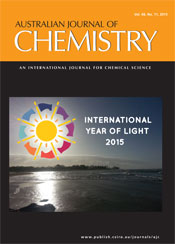
Australian Journal of Chemistry
Volume 68 Number 11 2015
International Year of Light 2015
CH15623International Year of Light and Light-Based Technologies

2015 is the International Year of Light and Light-Based Technologies, and this special issue highlights achievements in photochemistry and photophysics research from across the globe. The research topics presented range from the sustainable production of medicines to the advancement of modern technology.
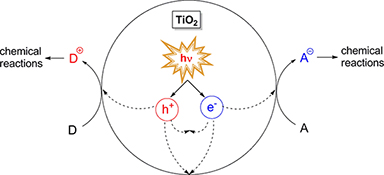
Titanium dioxide is a versatile inexpensive heterogeneous photocatalyst. Apart from many applications in environmental chemistry, numerous applications in organic synthesis have been reported. Selective oxidation and reduction of organic compounds and C–C bond formation reactions have been carried out.
CH153142-Aryl-1,3-dimethylbenzimidazolines as Effective Electron and Hydrogen Donors in Photoinduced Electron-Transfer Reactions
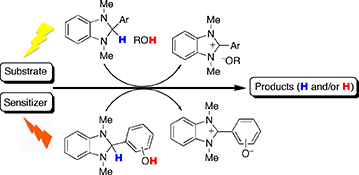
2-Aryl-1,3-dimethylbenzimidazolines (DMBIHs) act as effective electron and hydrogen donors for photoinduced electron-transfer reduction of various organic substrates in which photoexcitation of the substrates as well as photosensitization utilizing substituted pyrenes or transition metal complexes as sensitizers are carried out.
CH15396Visible Light-Promoted Metal-Free Reduction of Organohalides by 2-Naphthyl or 2-Hydroxynaphthyl-Substituted 1,3-Dimethylbenzimidazolines

Visible light excitation of 2-naphthyl- or 2-hydroxynaphthyl-substituted 1,3-dimethylbenzimidazolines (DMBIH) promoted the reduction reaction of some organohalides, involving the cleavage of aromatic as well as aliphatic carbon–halogen bonds. Addition of certain bases, such as 1,8-diazabicyclo[5.4.0]undec-7-ene, significantly enhanced the reducing ability of hydroxynaphthyl-substituted DMBIH.
CH15238Microreactor-Mediated Benzylic Bromination in Concentrated Solar Radiation
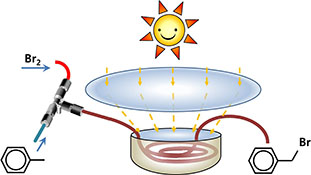
Sunlight-induced bromination of benzylic compounds was conducted in a capillary microreactor without an artificial light source or additional temperature control. These reactions can be considered to be eco-friendly.
CH15342A Facile Preparation of α-Aryl Carboxylic Acid via One-Flow Arndt–Eistert Synthesis
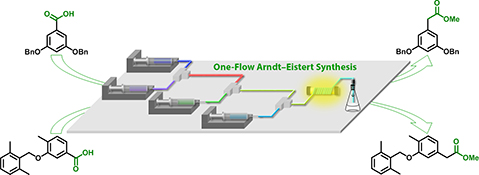
An efficient, one-flow Arndt–Eistert synthesis was demonstrated. A sequence of acid chloride formation–nucleophilic acyl substitution–Wolff rearrangement–nucleophilic addition was performed in a microflow system without isolating any intermediates, which included a potentially explosive compound. The microflow system was made from simple, inexpensive, and readily available instruments and tubes.
CH15356Photodecarboxylative Benzylations of N-Methoxyphthalimide under Batch and Continuous-Flow Conditions
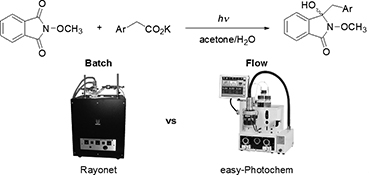
Photodecarboxylative benzylations of N-methoxyphthalimide were successfully realized and gave the corresponding benzylated hydroxyphthalimidines in moderate to good yields of 52–73 %. The photobenzylation was furthermore investigated in an advanced continuous-flow photoreactor, which enabled rapid optimization of the reaction conditions and achieved good yields after short residence times.
CH15115Formation of Carbanions from Carboxylate Ions Bearing Electron-Withdrawing Groups via Photoinduced Decarboxylation: Addition of Generated Carbanions to Benzaldehyde

The photoinduced decarboxylation of carboxylate ions bearing electron-withdrawing groups using biphenyl and 1,4-dicyanonaphthalene leads to the efficient generation of carbanions under mild conditions. In particular, the cyanomethyl anion formed using this photochemical method can be added to benzaldehydes to give the corresponding adducts.
CH15266Photoinduced Cycloadditions in the Diversity-Oriented Synthesis Toolbox: Increasing Complexity with Straightforward Post-Photochemical Modifications
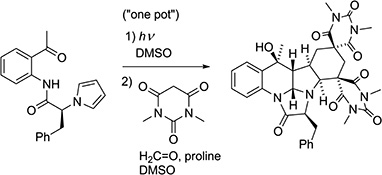
Unprecedented molecular architectures are accessed via intramolecular cycloadditions of photogenerated azaxylylenes. The approach is well-aligned with diversity-oriented synthesis, whereby photoprecursors are synthesised in a modular fashion allowing for up to four diversity inputs, with the complexity of the primary photoproducts being further enhanced using high-yielding post-photochemical steps.
CH15280Enantioselective Photochemical Rearrangements of Spirooxindole Epoxides Catalyzed by a Chiral Bifunctional Xanthone
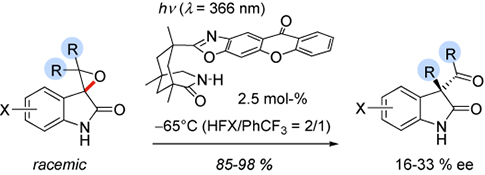
The photochemical rearrangement of spirooxindole epoxides was performed catalytically with a chiral bifunctional xanthone. The substrates are non-covalently bound via hydrogen bonds to the photochemically active catalyst, which presumably acts as a triplet sensitizer. Upon irradiation with λ 366 nm, the 3-acylindolin-2-ones were formed in high yields (85–98 %) and with enantioselectivities up to 33 % ee.
CH15404Contrasting Behaviour of Exciplex Ensembles in the Diastereodifferentiating Paternò–Büchi Reaction of Chiral Cyanobenzoate with Naphthyl- and Phenylethenes on Direct or Charge-Transfer Excitation
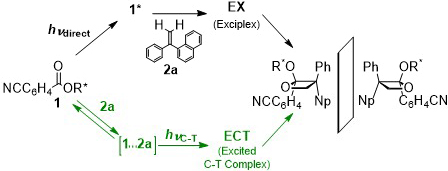
The effect of solvent polarity and temperature, as well as excitation wavelength, was examined for the diastereoselectivities of the Paternó-Büchi reaction of chiral cyanobenzoate with 1-(1-naphthyl)-1-phenylethene to reveal the different nature of the excited charge-transfer complex (ECT) and the conventional exciplex (EX). The exciplex ensemble was critically modulated by increased donor–acceptor interactions.
CH15062Simultaneous Observation of Triplet and Singlet Cyclopentane-1,3-diyl Diradicals in the Intersystem Crossing Process
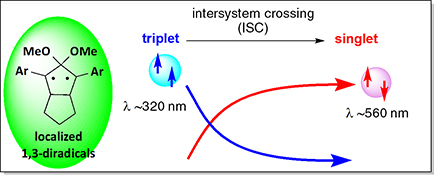
The rate constant of intersystem crossing (ISC), kISC ~3 × 107 s–1, for cyclopentane-1,3-diyl diradicals was unequivocally determined by the simultaneous observation of the decay process of the triplet diradical (λobs = 320 nm) and the growth process of the corresponding singlet diradical (λobs = 560 nm). The two spin states were directly observed using a long-lived singlet 2,2-dimethoxy-1,3-diphenylcyclopentane-1,3-diyl diradical.
CH15401Formation and Direct Detection of Non-Conjugated Triplet 1,2-Biradical from β,γ-Vinylarylketone

Intramolecular triplet sensitization of a simple alkene results in the formation of 1,2-biradical. Laser flash photolysis was used to detect the biradical directly; the biradical has a lifetime of a few microseconds. Density functional theory calculations reveal that two radical centres are localized on the adjacent carbon atoms.
CH15412Engineering Disorder at a Nanoscale: A Combined TEM and XAS Investigation of Amorphous versus Nanocrystalline Sodium Birnessite
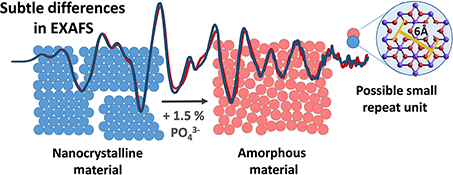
By coprecipitating a sodium birnessite-like phase with and without phosphate (1.5 %), we are able to engineer two very similar but distinct materials – one that is nanocrystalline and the other that is amorphous.
CH15337Colorimetric Detection of Nitroaromatics Using Organic Photochromic Compounds

Colorimetric detection of nitroaromatics using an organic photochromic compound is demonstrated.
CH15268New Red-Emitting Phosphor La2Zr3(MoO4)9:Eu3+ and the Influence of Host Absorption on its Luminescence Efficiency
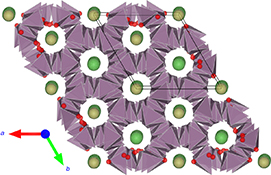
The new red-emitting phosphor, La2Zr3(MoO4)9:Eu3+, exhibits broad absorption bands due to admixed Zr4+, Mo6+, and Eu3+ charge transfer (CT) bands. The influence of the various means of excitation on the emission is investigated. A bi-sigmoidal temperature-quenching behaviour was observed and discussed in relation to the CT bands.
CH15249Photophysical Properties of Rare Earth Diclofenac Complexes in the Solid State
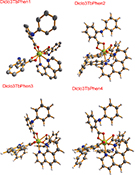
Efficient luminophores with quantum yields of 48 % were obtained for Tb(diclo)3phen and Tb(diclo)3bipy complexes, while analogous Eu3+ complexes remained inefficient with quantum yields below 13 %.
CH15283Study of Vertical and Lateral Charge Transport Properties of DPP-Based Polymer/PC61BM Films Using Space Charge Limited Current (SCLC) and Field Effect Transistor Methods and their Effects on Photovoltaic Characteristics
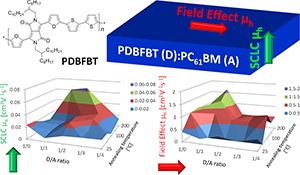
Vertical and lateral carrier mobilities of a polymer donor–PC61BM system were measured with the space charge limited current (SCLC) and field-effect transistor methods. Some blend films annealed at high temperatures exhibited an abrupt increase in the field-effect hole mobility, which was interpreted by an antiplasticization effect.
CH15381Aryl-Substituted Boron Subphthalocyanines and their Application in Organic Photovoltaics
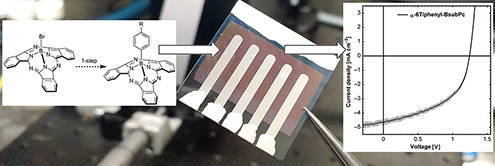
Boron subphthalocyanines (BsubPcs) have shown potential as functional materials within organic photovoltaics. In this paper, we revisit an understudied class of BsubPcs with an aryl axial substituent. We have described their relevant properties for application in organic photovoltaics, and incorporated them directly into photovoltaic cells. The resulting cells demonstrate the high potential of this class of BsubPcs within this area.
CH15241Tuning the Light Absorption of Donor–Acceptor Conjugated Polymers: Effects of Side Chains and ‘Spacer' Units in Thieno[3,4-b]pyrazine-Fluorene Copolymers
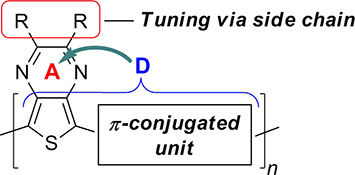
Donor–acceptor (D-A) copolymers of thieno[3,4-b]pyrazine (TP) and fluorene are reported in order to illustrate the ability to tune the light absorption properties of TP-based materials via basic structure–function relationships.
CH15284Synthesis and Characterisation of High Fullerene Content Polymers and Their Use in Organic Photovoltaic Devices
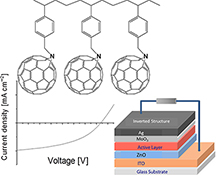
Narrow dispersity polymers with tethered fullerenes were synthesised and fabricated into organic photovoltaic devices, achieving up to 0.4 % efficiency.
CH15457An Alternating Donor–Acceptor Conjugated Polymer Based on Benzodithiophene and [3,4-c]pyrrole-4,6-dione: Synthesis, Characterization, and Application in Photovoltaic Devices
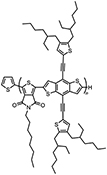
Materials for organic polymer solar cells should have maximized light absorption across the solar spectrum. An approach is described to synthesize donor–acceptor conjugated polymers that are optimized for light harvesting properties. The best candidate polymer is characterized using a range of photophysical techniques and its performance in solar cell devices evaluated.
CH15245Perovskite Solar Cells Based on Nanocrystalline SnO2 Material with Extremely Small Particle Sizes
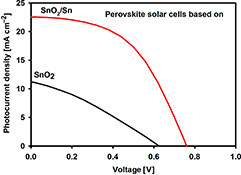
Tin oxide (SnO2) has been widely explored as electron-transport material in solar cells owing to its excellent mobility and transparency. This work reports on the application of SnO2 and SnO2/Sn nanoparticles in perovskite solar cells (PSCs). The study demonstrates a new approach to improve the performance of PSCs through material engineering.



